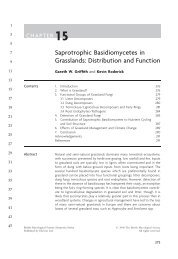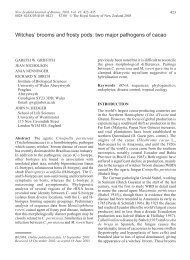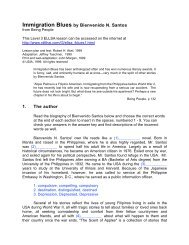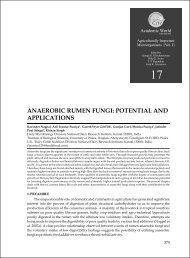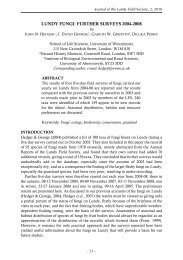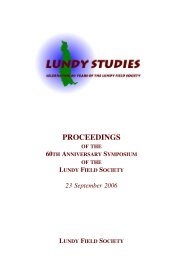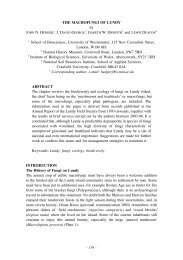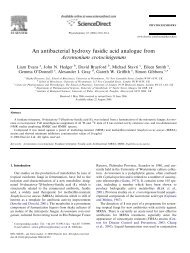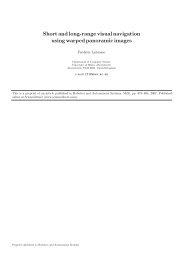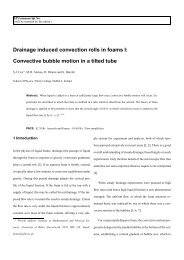Chytridiomycota - Users Site
Chytridiomycota - Users Site
Chytridiomycota - Users Site
Create successful ePaper yourself
Turn your PDF publications into a flip-book with our unique Google optimized e-Paper software.
microscopy. Species identified as being in the genus<br />
Chytriomyces occur in several separate, well supported<br />
clades indicating that Chytriomyces as currently defined<br />
is polyphyletic (FIG. 2).<br />
Although thallus morphology is divergent zoospore<br />
ultrastructure is conserved among the members of<br />
this clade. Most isolates from the Chytriomyces clade<br />
possess a Group I-type zoospore (Barr 1980) and form<br />
a clade that has been delineated as the Chytridiaceae<br />
(Letcher et al 2005). Features of that zoospore<br />
include a fenestrated cisterna, a lateral microtubular<br />
root composed of a bundle of approximately seven<br />
microtubules in a cord-like arrangement, and a pair<br />
of three stacked, flat, electron opaque plates adjacent<br />
to the kinetosome, a paracrystalline inclusion in the<br />
peripheral cytoplasm and an electron opaque plug in<br />
the base of the flagellum. Phlyctochytrium planicorne<br />
(Letcher and Powell 2005a) and Polyphlyctis unispina<br />
(Letcher et al 2005) have a Group II-type zoospore<br />
(Barr 1980), distinguishable from the zoospore of the<br />
Chytridiaceae primarily by the structure of the<br />
electron opaque plates adjacent to the kinetosome.<br />
Isolates with a Group II-type zoospore probably<br />
represent a separate family in the Chytridiales.<br />
Clade 3. Blastocladiomycota.—Traditionally considered<br />
among phylum <strong>Chytridiomycota</strong>, the Blastocladiales<br />
diverges from the core chytrid clade and is<br />
sister of a clade including Zygomycota, the chytrid<br />
genus Olpidium, Glomeromycota and Dikarya<br />
(FIG. 2). They are saprotrophs as well as parasites of<br />
fungi, algae, plants and invertebrates, and may be<br />
facultatively anerobic. Two major subclades are resolved<br />
in molecular phylogenetic analyses (FIG. 2),<br />
one composed of the plant parasite Physoderma and<br />
the other containing the remaining blastocladialean<br />
genera. The morphology of thalli of Blastocladiales<br />
parallels forms found among the core chytrid clade,<br />
ranging from monocentric to polycentric and mycelial.<br />
However Coelomomyces produces a tubular unwalled<br />
thallus in its host, reminiscent of hyphal bodies<br />
in the Zygomycete group Entomophthorales. The<br />
zoospore is functionally similar to those found among<br />
core chytrids with a single posteriorly directed<br />
flagellum, stored lipid and glycogen reserves, a characteristic<br />
assemblage of lipids, microbodies, membrane<br />
cisterna called the side-body complex (5microbody-lipid<br />
globule complex) and a membranebounded<br />
ribosomal cap covering the anterior surface<br />
of a cone-shaped nucleus.<br />
Major evolutionary changes have accompanied the<br />
divergence of the Blastocladiales from the core<br />
chytrids. For example the Blastocladiales have a life<br />
cycle with sporic meiosis whereas most core chytrids<br />
have zygotic meiosis, where known. The Blastocla-<br />
Mycologia myco-98-06-18.3d 4/1/07 13:38:51 867 Cust # 06-083R<br />
JAMES ET AL: PHYLOGENY OF CHYTRID FUNGI 867<br />
FIG. 3. Comparison of ultrastructural differences between<br />
the Blastocladiales and core chytrids. a. Longitudinal<br />
section through the closed mitotic pole of Catenaria<br />
allomycis with centriole (arrowed) separated from the<br />
internuclear spindle (Blastocladiales). b. Open mitotic pole<br />
of Powellomyces variabilis (Spizellomyces clade) with the<br />
centriole (arrowed) proximate to the mitotic spindle. c.<br />
Unstacked, single cisterna of a Golgi equivalent (arrowed)<br />
in Allomyces arbusculus (Blastocladiales) near rough endoplasmic<br />
reticulum. d. A Golgi apparatus with five stacked<br />
cisternae in Powellomyces variabilis (Spizellomyces clade).<br />
Notice smooth endoplasmic reticulum and small transport<br />
vesicles at the proximal (upper) side of the stacks and larger<br />
secretory vesicles at the distal (lower) side of the stack.<br />
Methods for sample preparation and microscopy are as<br />
previously published (Powell 1975). Bars: a, b 5 0.25 mm; c,<br />
d 5 0.125 mm.<br />
diales exhibits several ultrastructural features more<br />
characteristic of higher filamentous fungi than of the<br />
core chytrids, including closed nuclear poles during<br />
mitosis (FIG. 3a) rather than open (fenestrate) poles<br />
(FIG. 3b) and Golgi equivalents (Bracker 1967,<br />
FIG. 3c) rather than stacked Golgi cisternae (FIG. 3d).<br />
A Golgi apparatus with stacked cisternae has been<br />
reported in Physoderma (Lange and Olson 1980),<br />
suggesting this subclade might have diverged before<br />
the loss of Golgi cisternal stacking in the Blastocladiales.<br />
These distinctive ultrastructural characteristics<br />
as well as the phylogenetic placement of the group<br />
warrant their elevation to a new phylum, the<br />
Blastocladiomycota.<br />
Blastocladiomycota T. James, phylum nov.<br />
Synonyms: Allomycota Cavalier-Smith, BioSystems<br />
14:465, 1981 (not valid, no Latin diagnosis)<br />
Archemycota Cavalier-Smith, Biol. Rev. 73:246,<br />
1998 pro parta<br />
Zoosporum cum flagellum unum, corpus-latus<br />
complexe, nucleus pileus ex ribosomata membrane<br />
confinium, nucleus cum conus forma terminari<br />
propinquus kinetosoma, microtubuli ex propinqui-



